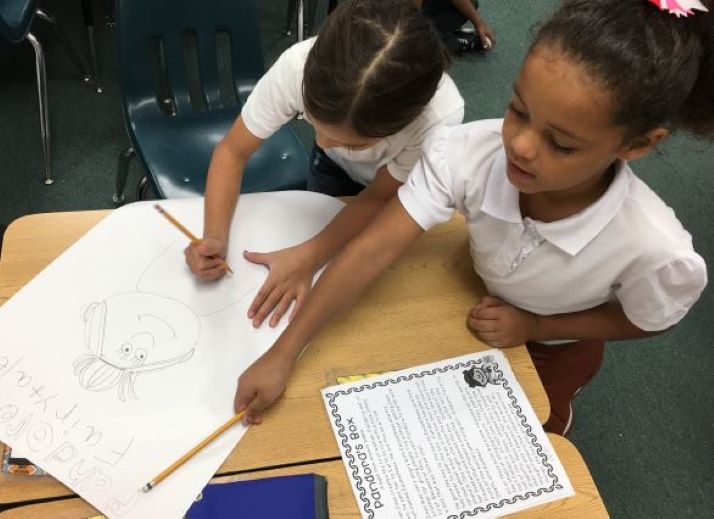Learning how to read involves complex and multi-faceted skills, so consequently teaching reading can be a daunting task. Educators who learn about the stages of child development, phases of language acquisition, effective instruction strategies and how to use available resources to provide engaging lessons may believe those are the only knowledge and tools they need. However, the metacognitive processes involved when a student learns to read and write are profound. Studying and understanding foundational learning theories of experts like Piaget, Vygotsky, and Skinner, for example, can provide valuable insight for educators and assist them when preparing learning environments and providing literacy instruction for their students.

(Public domain image)
Jean Piaget (1955) studied young children and “determined that the cognitive ability of children evolved in four distinct and unique stages” (Cobb & Kallus, 2011, p. 166). Students in a typical classroom have a wide range of abilities and are at various levels of cognitive maturity. A teacher’s awareness of Piaget’s stages of development can be beneficial to help her determine if students who are struggling lack the necessary skills or if they’re not yet developmentally ready for the specific concepts being presented. In addition, Piaget’s constructivist theory predicates that knowledge is derived from the interaction that people have with objects. Each person constantly establishes awareness and insight by classifying what he knows, then configuring and re-configuring his knowledge. (Hertez, 2010) Educators with familiarity of the constructivist theory will understand the importance of providing students opportunities to explore and interact with text in order to create their own structures of knowledge.
Lev Vygotsky is another expert whose theories can provide valuable insight for reading teachers. Vygotsky’s social constructivist theory is based on the belief that “socially meaningful activity is directly related to the cognitive development theory that learning is directly related to the social interactions that occur within the learning environment” (Cobb & Kallus, 2011, pp. 167-168). This theory puts emphasis on students interacting with each other versus each student individually interacting with objects like Paiget suggested. Vygotsky felt that children need to make social connections with others in order to personalize and retain the learning. This could affect the way teachers provide literacy instruction because they can adjust the way they group students in small groups, triads, or pairs for cooperative learning activities, setting students up for success with intentional groups for social connections. Another important theory of Vygotsky’s that has been influential in education is the zone of proximal development, or ZPD, which is the “gap between the child’s level of actual development determined by independent problem solving and her level of potential development determined by problem solving supported by an adult or through collaboration with more capable peers” (Dixon-Krauss, 1996, p. 15) Educators should provide instruction within a student’s ZPD to allow the student to use what he already knows as a foundation upon which to build new knowledge through the support offered from peers or teachers. This strategy of teaching the student where he is first, then challenging him to build on new learning while the teacher adjusts her support based on his responses can help move his learning forward, constantly changing his zone of proximal development to a higher level.

B.F. Skinner developed the theory of operant conditioning, which is based on the belief that a student’s learning behaviors can be controlled, or conditioned, by positive responses such as verbal praise or pleasant body language from the teacher like a smile. Skinner proposed that teachers should start out rewarding students with tangible prizes using a token or points system, then transition to personal approval when students are able to read fluently enough to experience personal enjoyment from reading itself. “Skinner’s theories regarding positive reinforcement radically changed the face of education, which, at the time, prided itself on rote learning and negatively punishing discipline” (Skinner, 1968). Teachers of literacy should be cognizant of how their responses to students’ attempts at reading and writing can influence the students’ confidence level and willingness to take risks to learn new skills. If they provide more positive responses to students, then it will encourage the students to increase their efforts. Also, students will view literacy activities as more enjoyable and want to improve.
In closing, studying educational theories from experts such as Piaget, Vygotsky, and Skinner can add depth and new insight to educators’ toolboxes, helping them improve their craft. Keeping these theories in the forefront of their minds while structuring their classrooms, preparing and implementing lessons, and interacting with their students can strengthen their overall effectiveness.
References:
Cobb & Kallus (2011). Historical, Theoretical, and Sociological Foundations of Reading in the United States. Pearson Education, Inc., Boston, MA.
Hertez, JM. (2010, October 4). Piaget on Piaget, Part 1 [Video File]. Retrieved from https://youtu.be/I1JWr4G8YLM
autismvid. (2011, July 21). B. F. Skinner on education, Part 1, fragment 1 [Video File]. Retrieved from https://youtu.be/cUzoa7Vv5sE

What an excellent resource for teachers to improve their understanding of active learning and social interaction. Thank you for sharing.